 HEY! Feel free to say hello, ask questions, or suggest an idea here at my web site or through Facebook. You can request to be put on my mailing list or recommend it to other drummers or any musician for that matter. *Go to the CONTACT section of this site.* I try to make the site an interesting resource and community for anyone wanting to grow in the skill the Lord has placed in them. The world wide drummer/ musician community is a pretty amazing group of people. Many articles I write, and class ideas come from my personal experience as a player & student of drumming, as well as the questions I hear from others. *My Friends page is full at Facebook, but you can go to my FAN page & click LIKE there if you want to follow what’s happening on my drum journey– https://www.facebook.com/CarlAlbrechtDrum OR you can also follow me on TWITTER – my name there is Carldrums. – https://twitter.com/#!/search/Carldrums
HEY! Feel free to say hello, ask questions, or suggest an idea here at my web site or through Facebook. You can request to be put on my mailing list or recommend it to other drummers or any musician for that matter. *Go to the CONTACT section of this site.* I try to make the site an interesting resource and community for anyone wanting to grow in the skill the Lord has placed in them. The world wide drummer/ musician community is a pretty amazing group of people. Many articles I write, and class ideas come from my personal experience as a player & student of drumming, as well as the questions I hear from others. *My Friends page is full at Facebook, but you can go to my FAN page & click LIKE there if you want to follow what’s happening on my drum journey– https://www.facebook.com/CarlAlbrechtDrum OR you can also follow me on TWITTER – my name there is Carldrums. – https://twitter.com/#!/search/Carldrums
Stay In Touch
Keepin’ The Juices Flowing

Carl in Italy
Ok, so it’s cool to play music, tour, work on recordings, teach, preach etc. etc. I’m very aware of how blessed I am that the Lord let’s me do the things I do. But to also maintain over-all health you’ve got to get out of your drum room, studio, or band jobs and do some other physical things. Eating right, exercise, and other interest will help your mental perspective AND keep your body in good playing condition. I don’t have one specific routine, and I’m by no means a work-out champion… but I’m always mindful of trying to take care of this “machine” the Lord has put me in… Our “earthen vessels” are amazing and yet delicate. If you fall in & out of good healthy routines don’t give up… just start again & again until it becomes more common for you to make healthy choices. I can’t say enough about asking for the Lord’s help in this matter. HE does give us strength for each day, and the wisdom to live well. I talk to the Lord about everyday choices and the “common” things of life just like I would the “BIG” spiritual issues. To those that live by the Spirit, everything is spiritual! Blessings on your journey! Watch this glimpse at one of my better choices…
Groovin’ The 5-Stroke Roll
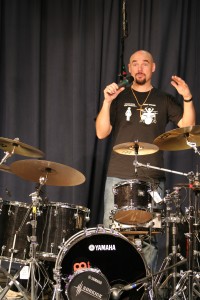
Carl's Drum Clinic
When I was a young drummer working on the rudiments seemed like such a waste of time. Of course as I learned more about the art of drumming I realized they were in every part of a drummers vocabulary whether they knew it or not. Listening to all of my heroes play and trying to figure out all of those “cool” patterns soon revealed a long list drumming rudiments. On this new project with Paul Baloche the guys wanted this type of driving military rock groove. The classic 5-stroke roll felt like the perfect start to the phrase. It is played RRLLR – the doubles are on the snare and then it ends up on the hi-hat on the downbeat of each bar. I guess it could have been played as singles. RLRLR – but that does not feel the same. In every clinic & seminar I teach the importance of building upon the standard rudiments, but always remembering to let the music be your guide. Enjoy the video.
Worship Drumming Essentials

Carl in worship
In my journey as a drummer it seems there are foundational concepts that ALWAYS have to be in place to do well as a musician and a worship leader. (Yes, you are a worship leader if you play before a group to lead them into the presence of the Lord. It’s just not about the singers or person out front.) These foundational concepts never seem to loose their significance. I guess you could say these are the pillars of a worship drummer’s life. These are the four elements that will always need to be in place if we are going to hit the mark in our calling.
I. Heart & Soul
II. Timing & Groove
III. Team spirit
IV. Playing to the room
I know there are many concepts, both technically and spiritually, that we use to play the drums in worship. But these four are really the corner tent pegs that hold it all together. I think everything else rest on these principles. All that I have ever shared and taught on the subject of drums in worship seem to be built on these four essentials. When any of them are out of place it seems the whole thing falls down!
First, “You gotta’ have heart… lots and lots and lots of heart.” These words from an old song still have the most profound meaning. As a musician, if you are not fully engaged in the emotions of the music you’re playing it will feel lifeless. I believe that playing with passion and purpose is felt by you, your fellow minstrels, and the people listening.
This concept is a little difficult to describe in technical terms. I can only testify to my own struggle with staying engaged emotionally with the music. I just know that music feels differently when I’m aware of what I am suppose to communicate, and that I am excited to tell the story. When my heart isn’t in it there is an energy that’s lacking. I think that is the “soul” part of music.
This is even more critical when it comes to worship. We must be worshipping when we play. It has to be more than getting the notes right. Playing with excellence is great to a certain level, but there is a realm of spiritual power that will only happen when we are playing to honor and love the Lord. The times I have been disengaged emotionally during a performance it felt rather lame. (*The word performance is only being used to refer to a time of playing*) Again, to specifically describe what is lacking in those moments is tough. I truly believe that the music is lifeless in some way and everyone suffers because of it. So, guard your heart! “THOU SHALT NOT PLAY THE DRUMS IN VAIN.”
Number two… Your sense of time and groove must be solid. This is the technical side of your playing. As much as your heart being in it is vital, so is your ability to do the job well. Keep working on your chops! Make sure you have every song worked out thoroughly. If you know there are spots in a tune that are challenging you, work on it some more. Using a metronome when you practice is most critical. Keeping the time solid and the groove feeling great is primo! Don’t be content with anything less than your absolute best. BUT, don’t get caught up in self-destructive thoughts either. I.e. “I wish I could play like that drummer.” OR … “I’ll never be able to get this right!” It’s OK to be inspired by other players but… “THOU SHALT NOT COVET THY NEIGHBORS DRUMMING”
Team spirit is the next pillar for a great worship musician. By the way, remember that each element is vital. Just because I’m using a particular order does not mean I’m placing more significance on one area. Besides having your act together on the spiritual and technical side you have to help your teammates as well. Ah…you thought this would be easy. NO WAY! Now, you have to build up your fellow worship warriors.
When you’re feeling strong look for those that are not having a good day and encourage them. Actually we need to do this whether we feel good or not. Rise above your emotions!! (Me too!) It could be something very small in your own eyes. Just a kind word or maybe helping the team set up can change the atmosphere. The ordinary things can have such a huge impact. Look for ways to build people up and you’ll find it becomes an emotional glue that holds you all together.
If you feel there is a spiritual void and no one is giving much attention to prayer and heart issues, you might be the one to draw the team into fellowship time. Don’t nag, but encourage the troops to gather in for a focused time before an event to meet with the Lord. Like great teams in sports always have a locker room gathering before a game, a worship team has got to pull together in the final moments before a service. Oh, by the way, ask the leader if it’s OK. Don’t just take over the role of leadership. Always strive to be the encourager! “THOU SHALT HONOR YOUR BROTHERS AND SISTERS.”
Last, but not least, be sure to play to the room you’re band must play in. Yes, this means to control your volume. Everything else could be in place, but if you overpower the room it will weaken all the other pillars. You could be a great drummer with incredible skill, have the passion to worship, and totally be the team player, but if you don’t adjust to the acoustic environment you’re in you’ve failed. Usually this means being too loud, but on rare occasions you might be playing too soft to get the band to sound good together. Sometimes you have to dig in a little bit to get the band to gel.
I just experienced this recently with Paul Baloche on our 2 week tour across Canada. One night we played a huge auditorium and I could play as hard as I want. The very next night it would be a smaller venue with terrible acoustics and I’d have to play the whole evening with “hot rods” and lighter sticks. I always work with the engineer and the whole team to be sure we sound as good as we can for whatever room we play. “THOU SHALT NOT KILL THE WORSHIP ATMOSPHERE.”
So you say, “Hey, Carl that’s only four; I thought there were Ten Commandments.” …Hey! Yo… give me a break! I’m not Moses, here!! Sheeesh! Anyway, enough of my cheesy humor. The point I’m trying to make is that these four pillars are really the primary things that come to mind when I’m playing. Every job seems to lean upon these concepts. All the other elements of being a great worship drummer rest on these four. At every conference or clinic these are the most discussed topics amongst players, worship leaders, and pastors. REALLY!! I’m being dramatic on purpose. You have to get this!!! Make these the cornerstones of your calling and you’ll truly be the drummer the Lord has called you to be.
Standing on the Rock,
Carl
Still Producing In Hard Times. The story of “The Same Love” Project by Paul Baloche

Paul Baloche band – coffee break at winter session
It was an interesting year for sure. Paul & I both lost our fathers, and others in the band, and other friends faced very strange & trying seasons. To say that many of us had been shaken would be an understatement. BUT… we press on. We pray, we encourage, we rest in the Lord, … we continue to turn Jesus in the midst of it all. The best thing to do in any season is to keep moving towards the Lord. (When I hear these songs it reminds me of those days).
Besides all the events and recording that Leann and I do through a year, I was honored, once again, to labor with my brothers in the Paul Baloche Band to release another collection of songs that turn our hearts to the Lord. It was a long process as we worked together to find just the right sounds and feel for every song that Paul & friends were composing. It has been the pattern for the last few projects to “take our time.” Paul wanted to live with the material more… hear it in different ways… and then feel free to try several versions before settling in on a final product. As you’ll see in the video we all enjoyed the process, and appreciate the chance to cultivate the art of worship music a little more meticulously. See the story in the EPK video.
OH,,, and be sure to get your copy at your local music store or on itunes and other digital servers. 🙂 *Please pay for your copy! THANKS, Your brother, Carl
Ten Cities, Ten Drum Kits
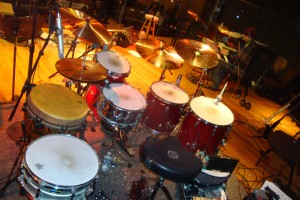
Grace Center Kit
Some of the fun & frustration of touring is playing a lot of different drum sets. I’ve probably played every make & model of kit through the years. I still miss my personal set when I’m traveling. Every detail of my Yamaha Maple Custom Absolute kit is just the way I want it. But, on the road, that doesn’t happen. I only travel with my cymbals and stick bag; and of course, my luggage. Airline fees have forced me to become more stealth in my travel planning.
Even though I send a “drum rider” describing the drums, heads, and set up I need; I always make the best of what actually shows up. Being a “drum diva” is not cool… and making a fuss about the drums just makes people uptight. And it just makes me look bad if I get “cranky.” 🙂 No matter what the job is (church or concert setting) I try to stay positive. Whether it’s an old beat up kit with dented heads and bent hoops, or if it’s the top of the line stuff, I’ll give it my best shot.
In all honesty, YES, the better the kit, the better it sounds… but usually with changing a few heads and some fine tuning, any kit can be made to work OK for at least one event. I’ve just learned to embrace the challenge, and try to learn something from every experience. *Like… “those types of shells don’t sound good to me.” OR… “this kind of hardware is harder to use than others.” Playing many kits really allows me the “privledge” of testing many instruments in a musical environment. Even the band will make comments about whether they like a particular drum set, snare drum, or even other cymbals I might use at a concert.
Right now I’m in the middle of a tour across Canada with Paul Baloche & Phil Wickham. I’ve played a Premier kit, Pear – Reference series, a DW – Top of the line, a PDP kit, and a Yamaha Stage Custom… All with different head combinations and shell dimensions. Some were in isolation booths, another on a huge stage, and then there was the small room where I had to play with hot rods & brushes all night. Who knows what I’ll get next… Yes, there were a couple of very frustrating moments when I could not get a kit to sound the way I like, but I just got it as close as I could. In other situations I was super impressed with a particular snare or tom sound. Either way I just play with passion and try to make the music feel good. “Thou Shalt Not Play Thy Drums In Vain!” – So it will be interesting to see how it goes playing 10 kits in 10 different cities. Thanks for your prayers.
Teaching & Drum Clinics

Carl's Drum Clinic
I still enjoy teaching & mentoring drummers. Whether young or old, new player or well seasoned performer, I love to encourage a drummer to grow in their musical skill. You can contact me through this web site by email, my home office phone, or by sending me a note at Facebook or other social media. It can take a while to schedule something according to my session & tour schedules, but don’t hesitate to let me know if you want a private lesson in Nashville, on the road at an event, or even a Skype or iChat hook up over the internet. Modern technology is amazing, isn’t it? You can also organize a drum clinic, or band clinic with your whole team – I would be honored to come to your town in person to do a teaching day.
*Leann & I are also doing full weekend training events with church teams and other performing groups… Let me know how we can be of service. You don’t have to wait for a large regional or national conference to book a special event for your church or team. http://leannalbrecht.com/2011/09/team-training/
Big Kit, Little Kit
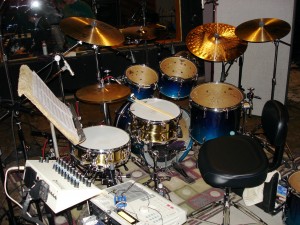
Standard Recording Kit for Carl
I really enjoy changing my drum set up around. Sometimes it’s a small kit – a 4 piece = kick, snare, 1 rack tom, 1 floor tom./ Hi-hat, Ride, & 2 crashes. Often, I add one more tom to that set up and an aux snare to the left of my hat. My standard recording kit right now has 10″, 12″, & 16″ toms; a 22″ kick; 14″ x 7″ Yamaha Brass shell, and a 13″ x 3″ Yamaha piccolo brass shell. (*Photo) I change the cymbal set up according to the music, but in the photo is what I normally start with. (Meinl Cymbals – 20″ Amun Ride, 18″ & 19″ Byzance crashes, & a 12″ splash. I have about 15 snares in my collection, but for most sessions I’ll take 5 or 6. In reality I do most projects with 3 or 4 – a Big Brass drum, a Standard Maple snare, a brass piccolo snare, and an old “fat” chrome-over brass. Toms & cymbals change according to the music.
I have several kits and tons of stuff to add on to my drum set ups. Every now and then I go crazy and set up everything I can get into my drum area. I like to stir up the creative juices by hearing all the different sounds that a large kit can deliver. This happens on the road too. I make it a point to try and play whatever they have available. Big kit, or small kit, I like to apply the instrument to the music I’m playing. I’m always mindful of honoring the artist I work with and what their music really needs. Paul Baloche always prefers smaller kits; 2 toms, maybe 3 at the most; and a few cymbals. No splashes or china cymbals for Paul-ie B.! Every now and then a big kit is at a venue and Paul will prefer a scale it down a bit. And I do whatever I can to make him comfortable with his music.
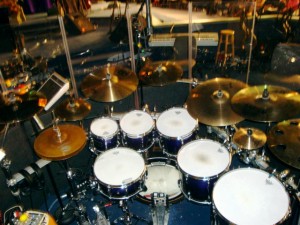
Big Kit in Chicago
Other artist, like Paul Wilbur or Don Moen are OK with a big set up, as long as I don’t go crazy and hit everything on each song. 🙂 Not a good idea, gang – keep that in mind! Paul Wilbur likes the added color and expression a big kit delivers. (*2nd photo shows a large kit I used at an event in Chicago.) He even likes me to add more emotion and musical drama to his music when it feels appropriate. AND THAT is the operative word… only when it’s the “appropriate” thing for the music. It’s not about the drums, or me, it’s about the music… Always “PLAY MUSIC”, NOT JUST DRUMS!” The thing about playing a big kit is to be mature enough not to hit everything. Just because a keyboard player has 88 keys doesn’t mean they play them all on each song, right? Apply that principle to your playing and you’ll think more musically. Be a GREAT MUSICIAN, whether it’s the big kit or little kit. Play every note with “heart!”
The BEST DRUMS EVER!!!
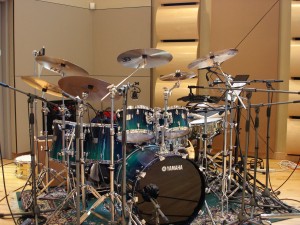
Carl'sRecordingKit-YamahaMapleCustomAbsolute
I’m about to reveal to you the greatest set of drums I’ve ever played. Without a doubt I know these drums will “blow away” any other drum kit out there. Don’t even try to change my mind on this, because I’ve played every kind of set of drums made in the world. All of the greatest drummers play them too. OK,,, READY?!,,, The best drums ever are $#@!#!#@#!$. What!,,, you say you couldn’t hear me. I said, $#@!#@!$#@!$#. They really are amazing. You must get them or you’re just not the most hip, cool, “up to date”, stylin’ cat out there; like all of the other really happenin’ drummers who play these drums.
OK, OK, STOP!!! For those of you that know me, you know I don’t get into these kinds of discussions. There is no “greatest drum set ever.” I’ve even worked in several drum shops through the years, and this was always part of the common shoptalk. “Oh, man, you should really get these!” or “What!,,, you’ve never played those drums? They’re the best! You’re really missing it, dude.” It didn’t take long for me to realize that the art of drumming is much more than what drum set you play.
My favorite equipment recommendation is to play what you love and what inspires you. It doesn’t matter if it’s Yamaha, Pearl, Tama, DW, Gretsch, or any of the other great drums out there. Play the drums that make you want to play! When you play “that” drum kit then you’ve found YOUR instrument. And don’t let anyone “mess with your head” about it.
What makes drums sound great is a great player making great music with a great team when everything technically comes together. Now that can be a very complicated thing, but let’s stay focused on the drum issue. We could also talk about cymbals, sticks, drumheads, etc. etc., but again, we will stay in drum world for this article.
In all drum making, even with custom-built drums, there are some elements that apply to everyone. I know there are a thousand variations in the small details, but we’ll focus on the big issues. Types of wood, the sizes, the rims, and the tom mounting system of the kit are probably the biggest factors of drum sound. And this isn’t even discussing the electronic and engineering options.
First, all maple drums will probably be the first item in every company’s catalog. I happen to play a Yamaha Maple Custom Absolute series kit with aluminum die cast hoops. A 22” kick; 10”, 12”, 14” & 16” toms (all standard depths); and a 14”x5” snare. (I do have other kits and about 15 snares, but this is my primary set up.) Yes, I think they’re awesome, and have been thrilled with the sound they create. But every maple kit has very similar characteristics. They all sound “BIG!”
Maple in general is a very hard wood, but it is also very resonant. I don’t know all of the technical reasons, but they are “punchy” and have a lot of tone. In some settings maple drums can be a little too big sounding. I’ve heard some people say the sound spreads out too much, and that they keep ringing too long. So if you want a more focused, tight sound maybe you should try birch or other drums.
Birch drums, like the classic “Yamaha Recording Custom” series, are amazing too. These drums were the early sound of Steve Gadd, Dave Weckl, Paul Leim and others. They have a little more mid-range in tone and have a little tighter punch. Now, does that mean better? … No, it’s just different. Especially when it comes to the sound of the toms. Many players like Gadd and Leim are using maple kick drums with birch toms. This would give you a huge, fat sounding kick, with toms that are a little more punchy in the mid range.
All the drum companies would advertise and price their maple & birch kits as the top of the line drums. Beyond that they would start to use other types of wood, and combinations of them. Perhaps combining these popular woods with mahogany or oak or others. If you are reading drum magazines and catalogs you probably find the variations pretty overwhelming. But honestly, what I’ve observed is that when you get into the less expensive drums they all sound more controlled and not as resonant. Which is not necessarily a bad thing. In some settings you don’t what the drums to sound so huge. If you play in smaller venues all of the time, a less resonant kit might work better. I’ve used Yamaha Oak drums or other inexpensive kits that sounded awesome, but they just didn’t sound as big. The key in most settings is tuning and head selection, which I’ve written about in other articles.
You could really put together whatever kind of drum kit you could imagine with the current list of options that are available. Although I personally like to hear a drum kit with the same tonal characteristics across all of the drums. Of course next week I could change my mind. Remember, this is art!
Besides types of wood, there are also variations in size and thickness of shell we could choose from. Deeper drums will sound fatter and maybe darker. Shorter drums will be punchier. Thinner shells will sound brighter than thicker shells and so on. If the drums have die cast hoops rather than machined steel they will probably have more of a snap or cutting sound.
The best way to tune your ear to these variations in sound is to go to a shop and try a lot of different drums. Don’t be a pest, but ask the store sales people if you can take some time to try things out. Try out everything and take mental note of what make & model your playing. Be sensitive to the workers and customers and try to do your testing in minutes and not hours of playing in a store. I think you’ll get excited as you discover what sounds inspire you. It’s amazing to play drums and feel that connection to a sound.
Always keep in mind what you’ll be using the kit for. Are you recording? Are you playing in mostly large rooms or small? Is the music more rock, pop, jazz, or is it a combination of everything. Of course you may feel you need more options, but you don’t have the budget or space to own several sets of drums. So how can you pick out a kit that will work for everything? In general the standard kit I mentioned earlier really does cover all of the bases. It’s a big investment up front, but it will last a lifetime if you take care of it.
If I’m playing in smaller venues I might only use the three smaller toms, use a smaller snare, and put more padding in the kick. When I don’t have to worry about the room I use everything and let them ring. I muffle as little as possible most of the time. Drums have a voice and I like to let them speak. Again this is always subject to what the job calls for.
No matter what type of kit I use I look for the tom mountings to be some kind of suspension system. Even on a cheap kit this can make all the difference in the resonance of the toms and how easily they will tune. Mountings that attach to the shell or go through the shell will usually distort the sound or choke them. Quite often I can’t get the drums to tune properly and one or all of the toms don’t “speak” or resonate well. Unless you want that old school tom sound you have to have isolation mounting for the toms. This feature has become very standardized in modern drum building and can be found on even the cheapest of drum sets.
I hope this helps keep your mind at ease if you’ve been wondering if your drums aren’t the “best drums in the world.” Or maybe this will help you in your journey if you have been thinking of a change in kits. Again, test a lot of drums and get your ears tuned in to what’s out there.
You might just add some pieces. Maybe smaller toms or a smaller kick drum would be a good idea in a small room. It could be that a cheaper, less resonant kit is more suitable to your situation. Buying a really loud, top of the line kit and putting a lot of muffling on everything is a terrible waste of money.
If you would like to, let me know how it’s going in your journey in discovering the sound of drums. You can write to my e-mail or the FAQ section at this web site. Happy drum hunting! Oh, and remember, don’t worry about finding the best drums in the world. I think they’re in heaven with Buddy Rich. Ha!!!!!!!!
Peace,
Carl
Fun With A 5-Stroke Roll
It’s so helpful to know the classic drum rudiments. I use them all the time for exercises & warm-ups. You can find them in most drum method books, and now on-line at many drum web sites. (*Download a pdf file for free at – http://www.pas.org/Learn/Rudiments.aspx )The rudiments are really the drummers alphabet. When you know them & build upon the concepts you will really expand your drum vocabulary.
In this little video clip I was just warming up at a sound check (softly). I was messing around with a 5-stroke roll. (RRLLR – LLRRL) But rather than ending on the snare I just played the last note on the kick. RRLLK. Nothing fancy, but a very musical idea I’ve used on occasion. You can experiment with any idea you learn and make it as creative & musical as you want. The key is to always be musical and think melodically. Make the drums “sing.”







Recent Comments